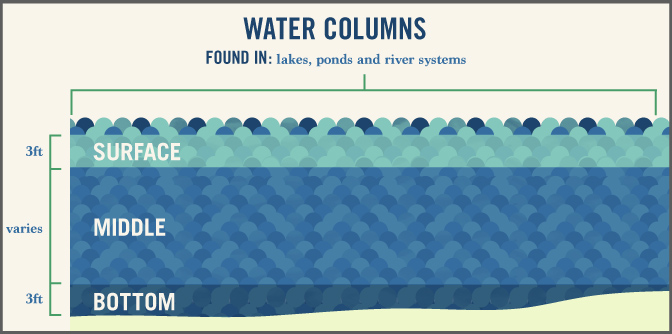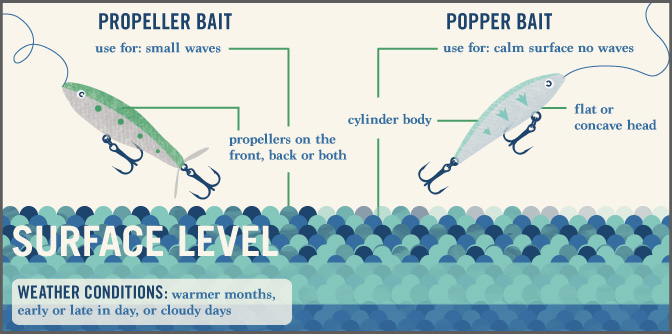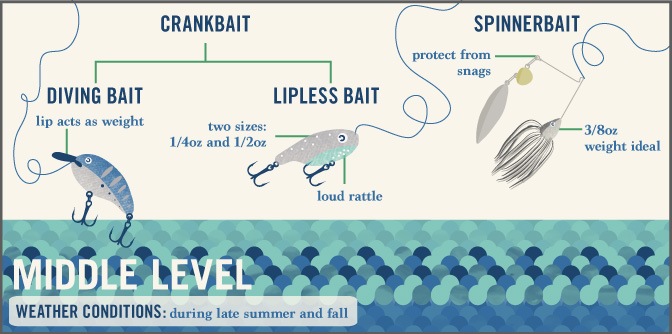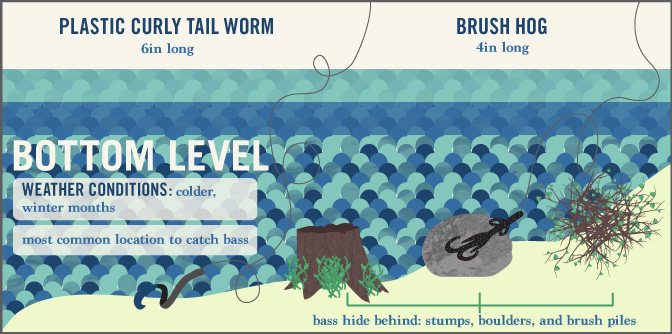Tackling Bass Lure Basics
Bass Lure Selection Simplified
Most bass fishing anglers own enough artificial lures to fill a small tackle store.
Yet a bass angler only needs a handful of baits to catch bass on most waterways.
Tackle manufacturers prey on the fact that anglers are like children in a candy store,
everything looks good! If we stay focused on the task at hand we can save a lot of money
and still catch as many bass as the next angler. To help us stay focused, let’s simplify
what an angler needs to catch bass by breaking a waterway down into three water columns
and then the lures needed in those water columns.
These three water columns apply to lakes, ponds and river systems. The surface column is
everything three feet deep or less. The bottom column is everything within three feet of
the bottom. What’s left is the middle column, which is all the water between the surface
and the bottom water columns. The majority of bass will be in one of these three water
columns based on time of year and time of day. Our lure presentations should be based on
the water column we think the most bass are in.

Surface Water Column Lures
During warmer months and low light conditions bass will spend significant time near the surface
of the water column. This happens early and late in the day, or during cloudy days. In these
conditions an angler should look to surface baits to attract actively feeding bass. There are
hundreds of choices when it comes to surface baits, but you really only need two; a popper style
bait and a propeller style bait. The popper will have a cylinder body with a flat or concaved face.
This shape allows the bait to make a “blooping” noise and splash water when it is twitched on the
surface. Use popper style baits when the water’s surface is calm with little to no wave action.
The propeller style baits are just that, baits that have propellers on the front, back, or both.
Propeller baits have a lot of flash when pulled across the surface of the water; they also make a
lot of commotion as the propellers churn the surface. Use propeller baits when the wind has created
a ripple or small wave action on the surface of the water.
Color choices should always resemble the local forage, most often this will be some sort of silver to
imitate shad or minnows; however, bluegill or perch may also be a local forage that creates additional
options. Even with the thousands of top water lure options on the market today, an angler will find
success with one of these two styles of lures during any top water conditions.

Middle Water Column Lures
The majority of a bass’s life is spent in the middle water column. This is where bass travel between
feeding and resting grounds. Also, during late summer and fall, nearly all the bass will be in this
section of the water column chasing migrating bait fish. Our bait options in this water column are
crankbaits, both diving and lipless, and spinnerbaits. These baits are relatively easy to use and
can be fished at most any depth simply by adjusting the retrieve.
When fishing crankbaits, the goal is to find out how deep and how fast you need to retrieve your bait
to catch bass. The only way to find the answer to this question is to start casting. Cast your bait out
and retrieve it with a variety of retrieves, fast and slow, until you get a strike. Once you get a strike,
repeat that process. Keep in mind, the depth of a crankbait is relative to the retrieve speed and maximum
depth capability; the faster you retrieve it the deeper it will go. By changing your retrieve speed you
are changing the depth at which the bait travels. Most billed crankbaits come with a depth rating,
determining how deep your bass are feeding will help you choose which bait to use. When setting up your
tackle box, having two selections from each depth category will be sufficient.
Lipless crankbaits are categorized by weight instead of the depth they dive. Since it’s a sinking lure,
cast it out and count it down to the depth bass are holding and start your retrieve. Just like with the
billed crank baits, use varying speeds until you get your first strike and then repeat that speed. A slower
retrieve makes this bait run deeper. Lipless crankbaits usually have extremely loud rattles in them that
attract bass when they are in an aggressive feeding mood. If you find a group of feeding bass, a lipless
crankbaits can help you catch a lot of them very quickly. It’s wise to have two sizes in this lure group,
¼ ounce and ½ ounce, to allow you to fish a larger variety of depths. Color options are along the same theme
as the rest of the lures, silver for shad and minnow forage. In keeping selection simple, silver with a black
back and silver with a blue back are really the only two colors you need for this lure. Choose the best color
to use based on water and sunlight conditions. In darker conditions use the darker versions.
Spinnerbaits enable an angler to present baits to bass that are in the middle water column yet associating
to cover like grass or standing timber. The blades of a spinnerbait will protect the hook point from
troublesome snags, yet fall free of the hook point when a bass strikes. The blades of a spinnerbait create
a lift in the water, so the faster you retrieve a spinnerbait, the closer to the surface it will travel.
A medium retrieve is a great starting point, then vary faster and slower until you get a strike.
When selecting a spinnerbait, there are only two colors an angler needs: First, white with silver blades
for clear water; second, chartreuse with gold blades for stained or muddy water. Fortunately there are
not as many color options with spinnerbaits so it’s easier to stay focused. However, an angler can get
lost in the blade options on those spinnerbaits. There are many different styles, shapes and colors of
spinnerbait blades. While there is a time and a place that one blade shape might produce more strikes
than another, there is a blade shape that is effective in all situations and that is the Indiana blade.
The Indiana blade is shaped like a teardrop and produces a lot of flash and vibration; it’s basically a
combination of all the blade styles wrapped into one. The Indiana bladed spinnerbait is as effective as
any spinnerbait on the market. Spinnerbaits come in a variety of weights ranging from ¼ ounce to 1 ½ ounce.
Nearly all spinnerbait applications can be satisfied with a 3/8 ounce version so there is no need to purchase
all the varying sizes. By varying your retrieve speed you can control the depth a spinnerbait travels in the
water column.
Color options for middle water column baits are only limited by a manufacturer’s imagination, and anglers get
caught up in this. I’ve had anglers tell me that I needed a lure that was silver with a black back and just a
spot of orange on the belly, or that it had to have a green dot near the tail. It has been my experience, a
handful of colors are all that is needed. Sticking with the forage for the given water, you can narrow this
selection down tremendously. Silver or white are good starting point because they mimic shad and minnows in
a lake or river. If you live in an area that has perch or a special variety of bream, it is also possible to
find a lure in that color. However, don’t get caught up in all the color varieties. Here is a perfect example.
Kevin VanDamn wins a bass tournament with a crankbait in a color called “Sexy Shad”. It’s a great color that
mimics shad that are found in nearly every body of water in North America. Within just a few months new color
versions, Sexy Citrus Shad, Sexy Melon Shad, Chartreuse Sexy Shad, started coming out and anglers immediately
started to purchase them. Before long, anglers had to have a separate tackle box just to house all the sexy
had versions they bought. The bottom line, the original “Sexy Shad” was all an angler really needed. Stay
focused on the waterways you’ll be fishing and the forage in them and chose your middle water column baits
accordingly.

Bottom Water Column Baits
The last water column is the bottom. Colder, winter months will be the best time to fish in the bottom water
column. This is the most common location that anglers attempt to catch bass. It can be very effective because
bass like to hide in or around things along the bottom of the waterways. Things like boulders, stumps, man-made
brush piles, anything that a bass can sit next to will provide shelter, security and an ambush point. All things
that provide cover for bass also provide frustration for anglers because our baits will get hung-up in them.
This is where we turn to a weedless presentation, a plastic worm or creature bait (creature baits are any
soft plastic with multiple appendages). With these baits we are trying to imitate forage that live on the bottom
of the lakes and rivers. The most notable forage in the lowest water column is a crawfish (also known as crawdad
or crayfish). Consider the color of your local crawfish when selecting a soft plastic lure. As with any bait
choice, you’ll have better results if you match your choices to the local forage. Some other bottom dwelling
species to consider are bream, sucker fish, and various shiners.
While there are many different ways to rig soft plastics, the two easiest are with a jig head with a weed
guard or Texas style. Both of these presentations will provide protection from hanging up.
For some, soft plastic baits are an obsession, carrying twenty plus tackle boxes dedicated to just soft
plastic baits. In the beginning I was also addicted to the variety; however, over my 40 years of fishing
experience I learned that three simple color options and two bait choices will catch bass in the bottom
water column. The six inch plastic curly tail worm and a four inch brush hog are my bait choices. Black with
red flakes, watermelon, and June bug will provide color options for all water conditions from clear to
muddy. In addition, add colors that resemble native forage in your area.
If you keep the water columns in mind and match lure choices with local forage, it’s easy to see that
anglers do not need a portable tackle store to catch bass. A bass is an opportunistic predator that will
eat anything that looks alive and will fit in its mouth. As anglers, we just need to create the
opportunities bass are looking for by presenting lures in the correct water columns. Lures are tools; you
have to have the right tool for the job. With just a few baits, you can have all the right tools for any job
on the water.

Embed the article on your site

